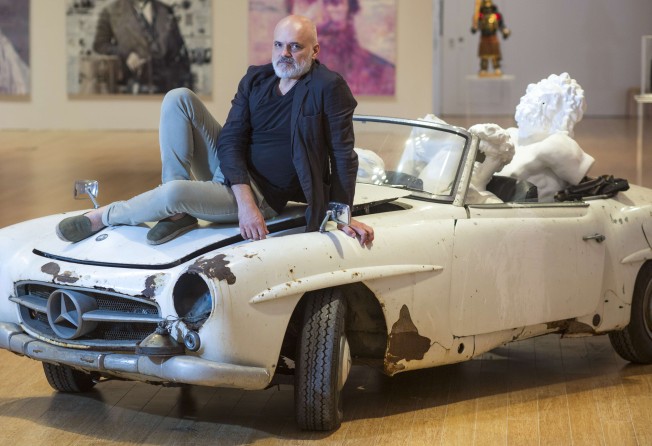
Konstantin Bessmertny’s art celebrates missteps in the messy jumble of life
The Russian artist’s recent work, featured in a Macau Museum of Art show, is a virtuoso display, with the privileged and corrupt the targets of his skilful wrath

Konstantin Bessmertny’s exhibition of recent work at the Macau Museum of Art is a virtuoso display of painting, sculpture, video, installation, doll’s house sized dioramas and stinging one-liners, motifs, graffiti and commentary that focuses on life’s missteps and celebrates the jumble of being alive in a messy world. The privileged and corrupt, with their greed and excesses, bear the brunt of Bessmertny’s big stick while the art market’s primary interest in money runs as a sub-theme throughout the show.
Born in the Soviet Union but having lived in Macau and Hong Kong since 1993, Bessmertny’s Russian political sensibility and the shadow of his family’s repression during Joseph Stalin’s political purges underline the exhibition.
Rather than heavy-handed messages, he employs parody and irony to make his point, beginning with the exhibition title, “Ad Lib”. The Latin term ad libitum literally means “at one’s pleasure” – it equates to freedom and, in music, improvisation. Ironically, it suggests the opposite of much of the exhibition’s targets. It also highlights Bessmertny’s free-form approach to art-making, with his formidable graphic and painting skills.
He may quote serious texts by 19th-century anarchists Mikhail Bakunin and Errico Malatesta but his breezy design sense, skilled technique and retro, varied typefaces ensure a richly layered visual experience.

This drawing is of a heaped stack of pigs, with the “artist” at bottom, followed by, in order, the “art gallery”, “art curator”, “art biennial”, “art critic” (definitely me!), “art collector” (possibly exhibition viewers!), “art fair”, “art museum” (the artist’s sponsor!), “art foundation”, “corporate art collection”, “art auction” and “art trend”.
In other paintings, the “artist” may be depicted by an Everyman or woman, surrounded by avariciousness, vanity and fame. Two large hemispherical paintings are the standout works in the exhibition. The Battle of Macao depicts the territory’s long history and highlights two pivotal events: the defeat of an invading Dutch force in 1622 and the end of the city’s gambling monopoly, in 2002. Bessmertny says, “The first made Macao the ‘Venice of the Orient’, and the second made it the capital of ‘opulent kitsch with the silliest cultural throwback of all time’.”
Its companion piece is G.S.F.S. (Greed, Stupidity, Fear and Sloth) (2013), inspired by Albert Einstein’s remark: “Three great forces rule the world: stupidity, fear and greed.” Bessmertny adds another: sloth, which, he says, “makes people enslave others, delegate, procrastinate and, paradoxically, invent ways and technologies to avoid work”.

G.S.F.S. is a rambling landscape of characters similar to Peter Blake and Jann Haworth’s famous cover for The Beatles’ 1967 album Sgt. Pepper’s Lonely Hearts Club Band. Rather than expressing the artist’s own narrative, the painting prompts speculative stories from viewers. These two paintings are melded together as a complete sphere and, powered by a hidden motor, slowly rotate in continuous motion. Life – the good and bad – is circular and goes on and on.
In contrast, Bessmertny’s thoughts are confidently expressed on a large wooden sculpture of a lion, Bestiarium (2012), covered in political graffiti. And to stress the decline of serious culture and, in particular, the waning popularity of classical music, Bessmertny uses decorated cellos and double basses, to act as a talisman “for musicians to defend themselves from aggressive representations of popular culture”.
And using the background of Ride (2016), an installation of a tatty Mercedes-Benz cabriolet filled with plaster copies of classical Greek sculptures, a beautiful model poses in a contrived advertising shoot with the mock text exclaiming: “A developed country is not a place where the poor have cars but a place where the rich use public transportation.”
Such hyperbole sits like guilty evidence at a crime scene. In Bessmertny’s hand, the world is a wonderfully rambling crime scene.
“Ad Lib – The Recent Work of Konstantin Bessmertny” is at Macao Museum of Art until May 28.